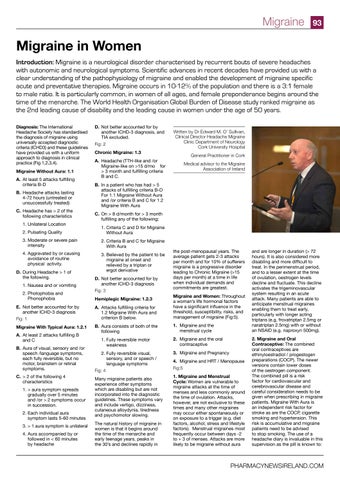Migraine
93
Migraine in Women Introduction: Migraine is a neurological disorder characterised by recurrent bouts of severe headaches with autonomic and neurological symptoms. Scientific advances in recent decades have provided us with a clear understanding of the pathophysiology of migraine and enabled the development of migraine specific acute and preventative therapies. Migraine occurs in 10-12% of the population and there is a 3:1 female to male ratio. It is particularly common, in women of all ages, and female preponderance begins around the time of the menarche. The World Health Organisation Global Burden of Disease study ranked migraine as the 2nd leading cause of disability and the leading cause in women under the age of 50 years. Diagnosis: The International Headache Society has standardised the diagnosis of migraine using universally accepted diagnostic criteria (ICHD3) and these guidelines have provided us with a uniform approach to diagnosis in clinical practice (Fig 1,2,3,4). Migraine Without Aura: 1.1 A. At least 5 attacks fulfilling criteria B-D B. Headache attacks lasting 4-72 hours (untreated or unsuccessfully treated) C. Headache has > 2 of the following characteristics 1. Unilateral Location
D. Not better accounted for by another ICHD-3 diagnosis, and TIA excluded. Fig: 2 Chronic Migraine: 1.3 A. Headache (TTH-like and /or Migraine-like on >15 d/mo for > 3 month and fulfilling criteria B and C.
3. Moderate or severe pain intensity
2. Criteria B and C for Migraine With Aura
4. Aggravated by or causing avoidance of routine physical activity.
3. Believed by the patient to be migraine at onset and relieved by a triptan or ergot derivative
2. Photophobia and Phonophobia
Medical advisor to the Migraine Association of Ireland
C. On > 8 d/month for > 3 month fulfilling any of the following: 1. Criteria C and D for Migraine Without Aura
1. Nausea and or vomiting
General Practitioner in Cork
B. In a patient who has had > 5 attacks of fulfilling criteria B-D For 1.1 Migraine Without Aura and /or criteria B and C for 1.2 Migraine With Aura
2. Pulsating Quality
D. During Headache > 1 of the following.
Written by Dr Edward M. O’ Sullivan, Clinical Director Headache Migraine Clinic Department of Neurology Cork University Hospital
D. Not better accounted for by another ICHD-3 diagnosis Fig: 3
the post-menopausal years. The average patient gets 2-3 attacks per month and for 10% of sufferers migraine is a progressive disorder leading to Chronic Migraine (>15 days per month) at a time in life when individual demands and commitments are greatest.
E. Not better accounted for by another ICHD-3 diagnosis Fig: 1
A. Attacks fulfilling criteria for 1.2 Migraine With Aura and criterion B below.
Migraine and Women: Throughout a woman’s life hormonal factors have a significant influence in the threshold, susceptibility, risks, and management of migraine (Fig:5).
Migraine With Typical Aura: 1.2.1
B. Aura consists of both of the following
1. Migraine and the menstrual cycle
A. At least 2 attacks fulfilling B and C B. Aura of visual, sensory and /or speech /language symptoms, each fully reversible, but no motor, brainstem or retinal symptoms. C. > 2 of the following 4 characteristics 1. > aura symptom spreads gradually over 5 minutes and /or > 2 symptoms occur in succession. 2. Each individual aura symptom lasts 5-60 minutes 3. > 1 aura symptom is unilateral 4. Aura accompanied by or followed in < 60 minutes by headache
Hemiplegic Migraine: 1.2.3
1. Fully reversible motor weakness 2. Fully reversible visual, sensory, and or speech / language symptoms Fig: 4 Many migraine patients also experience other symptoms which are disabling but are not incorporated into the diagnostic guidelines. These symptoms vary and include vertigo, dizziness, cutaneous alloydynia, tiredness and psychomotor slowing. The natural history of migraine in women is that it begins around the time of the menarche and early teenage years, peaks in the 30’s and declines rapidly in
2. Migraine and the oral contraceptive 3. Migraine and Pregnancy 4. Migraine and HRT / Menopause Fig:5 1. Migraine and Menstrual Cycle: Women are vulnerable to migraine attacks at the time of menses and less commonly around the time of ovulation. Attacks, however, are not exclusive to these times and many other migraines may occur either spontaneously or on exposure to a trigger (e.g. diet factors, alcohol, stress and lifestyle factors). Menstrual migraines most frequently occur between days -2 to + 3 of menses. Attacks are more likely to be migraine without aura
and are longer in duration (> 72 hours). It is also considered more disabling and more difficult to treat. In the perimenstrual period, and to a lesser extent at the time of ovulation, oestrogen levels decline and fluctuate. This decline activates the trigeminovascular system resulting in an acute attack. Many patients are able to anticipate menstrual migraines enabling them to treat early, particularly with longer acting triptans (e.g. frovatriptan 2.5mg or naratriptan 2.5mg) with or without an NSAID (e.g. naproxyn 500mg). 2. Migraine and Oral Contraceptive: The combined oral contraceptives are ethinyloestradiol / progestogen preparations (COCP). The newer versions contain lower doses of the oestrogen component. The combined pill is a risk factor for cardiovascular and cerebrovascular disease and careful consideration needs to be given when prescribing in migraine patients. Migraine With Aura is an independent risk factor for stroke as are the COCP, cigarette smoking and hypertension. This risk is accumulative and migraine patients need to be advised to stop smoking. The use of a headache diary is invaluable in this supervision as the pill is known to:
PHARMACYNEWSIRELAND.COM


































